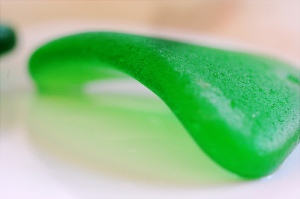
English: Hippocampus zosterae at the Birch Aquarium, San Diego, California, USA. (Photo credit: Wikipedia)
- The female lays her eggs in the male’s tummy pouch, he then incubates them for about 30 days, then they hatch.
- Seahorses do not have a stomach; they eat constantly to help get enough food to digest.
- Seahorses do not have teeth; they have a fused jaws, so they kind of suck up their food like a straw.
- Seahorses can be an inch to a foot more in size.
- Seahorse species vary in monogamy.
Do you have another great question? Check out www.beachchairscientist.com and let us know what you always ponder while digging your toes in the sand!
 that you find have spent a considerable amount of time floating in the ocean. It has been tumbling along the sand and water for so long that that the glass, slate or what have you, has been polished by the sand grains.
that you find have spent a considerable amount of time floating in the ocean. It has been tumbling along the sand and water for so long that that the glass, slate or what have you, has been polished by the sand grains.






What people are saying …